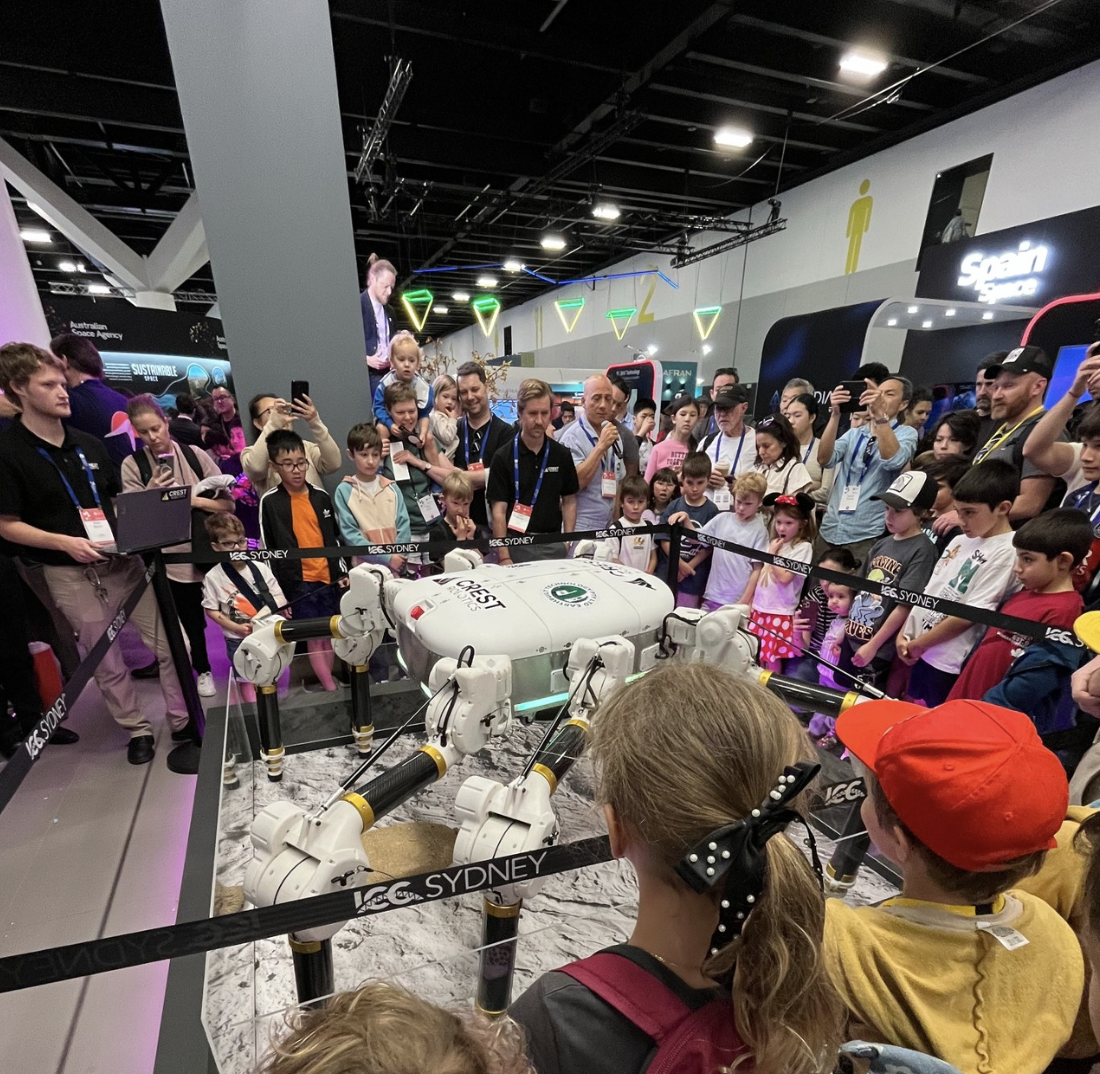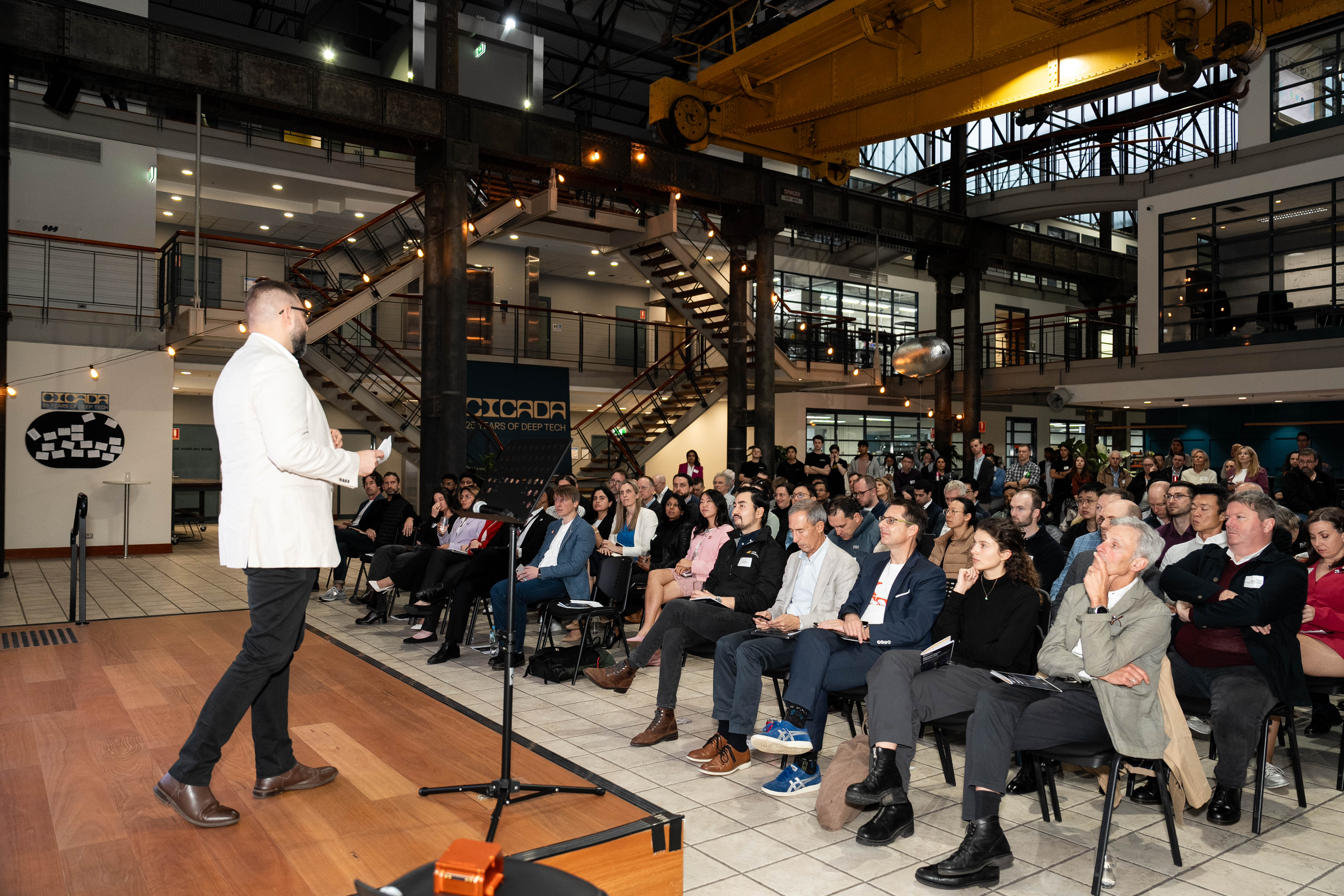Cicada Spotlight: Clyde Webster from Crest Robotics

Get to know Cicada resident and graduate from the National Space Industry Hub Space Elevate and Fast Start Program, Clyde Webster, founder and CEO of Crest Robotics.
Who is Crest Robotics? Can you tell us more about the team's background and what inspired you to focus on workplace safety through robotics?
I’ve always believed that robots are just the next stage in the development of tools to perform physical work. The word robot originated from a Czech word meaning ‘labour’, and so seemingly, having robots perform physically laborious tasks has been the goal for their entire existence. But why do we want ‘robots’ that can do this? For me, the natural answer has always been for the safety and well-being of people.
In my very early days, fresh out of high school, I used to labour for concerts and festivals. It became clear to me that physical health and fitness are not a luxury for some people; it is their livelihood. This is something I again appreciated in 2020 when I experienced a debilitating back injury that caused me to spend about one and a half years unable to spend more than an hour or two standing or sitting without excruciating pain.
According to Safe Work Australia, more than 497,000 injuries were reported in 2021-22 and more than 1 million weeks in lost labour in Australia. That's too high; I believe we can use robots as a tool for improvement.
At Crest Robotics, we focus on dangerous and extremely repetitive work. In the long term, we hope to have a robotic assistant for everyone in any job that involves a large element of physical labour. Although the Crest Robotics team is small, we are a dynamic team comprised of myself, Dr Felix Kong, a UTS lecturer, and Rohan Patel, a mechatronics engineer. Each of us met in the labs at UTS Techlab through various research and engineering work, and each of us has a strong desire to improve and build products that can meaningfully impact society.
The focus on safety is a call to arms for everyone on my team and resonates with almost everyone I interact with, from mentors to investors to potential customers. Each, like most, has experienced injury to either themselves or someone close to them and can speak for how debilitating it can be both physically and mentally, and all are both motivated and enthusiastic to apply their knowledge or to help the cause.
We understand Crest Robotics is developing advanced robots to eliminate workplace injuries. Can you elaborate on the specific types of robots you're creating and the industries you're targeting?
At Crest Robotics, we believe everyone should have the right to a safe and comfortable working environment. Our robots are designed to enhance human workers' agency, extending their capabilities through tools that can be remotely controlled or instructed to do work.
Our flagship product, Poly, the world’s first three-limed parrot-inspired robot, is currently under development and will initially be used in the energy sector. Workers will use it to remediate the transmission towers that hold up the lines that transmit electricity around the country. Typically, this task requires workers to climb tall structures and operate heavy blasting equipment to string back failing coatings that prevent rust before washing and repainting the tower. It is an expensive and dangerous job, and often hard to recruit employees. It’s also prohibitively expensive, with the cost of remediation on a single tower costing up to 40% of the cost of simply replacing the tower. The sand used during this process can easily damage houses and cars if it is picked up by the wind. For this reason, work is extremely dependent on weather conditions, further contributing to the high cost of work.
With a robotic implementation like Poly, we can use new laser blasting technology to completely remove the issues with sandblasting from the process. This results in a clean, sustainable, and cost-effective process that ensures workers' longevity and safer and more consistent work for the contractors. Long term, we’re designing Poly to be capable of using any tool it is equipped with. Giving labourers robotic tools to supplement the physical components of their jobs ultimately reduces stress on the workers' bodies, making hard jobs safer and more cost-effective. Here’s a selection of tasks we imagine for Poly’s future:
- Poly with a small excavator bucket for excavating narrow trenches in residential properties.
- Poly with a high-pressure water attachment for climbing up on a roof and clearing gutters.
- Poly with a nail gun climbing the trusses of houses and assisting builders more quickly and with less risk to themselves building houses.
- Poly with a spade shovelling dirt into a robotic wheelbarrow while its operator measures and plans the day's work.
- Poly with a welding attachment getting in confined spaces to perform welds.
Beyond this first application, we’re also looking for further adoption in the construction, manufacturing, and space industries, where heights and confined spaces are also common risks. Our robots are not intended to replace the intuition and skillsets of experienced workers. We intend to enhance each worker's capabilities so that they can produce a greater output with their robot and, in this way, contribute to a solution for the labour shortages we experience.
What are Crest Robotics' biggest challenges in bringing these robots to market? How do you envision human-robot collaboration evolving in the future workplace?
The first and hardest challenge is building and demonstrating that what we envision is possible. From a technological perspective, we know it is, but getting there is a journey fraught with risks. Developing such machines requires capital. There’s no way around it, and securing capital for a high-risk venture is difficult. Currently, we’re taking steps to mitigate these risks by finding early adopters who want to use the technology, but we’re also finding smaller problems we can solve immediately, both as a strategy to increase confidence in our business and operating philosophy and in generating confidence that we can quickly and effectively bring robotic products to market.
What is a recent success you are most proud of?
Crest Robotics is proud to have recently been involved in the launch of Australia’s largest Spacecraft, Optimus, designed and built locally by Sydney-based company, Space Machines Company. Crest Robotics was involved as a contractor providing services in the design and implementation of mass estimation and adjustment techniques.
Crest Robotics has also made its first sale to Transgrid on its first robotic product, the Gorilla Mk1. The Gorilla is the first in a line of advanced robotic products we’re bringing to the energy sector and does the job of deploying safety systems on transmission lines for maintenance projects. Broadly speaking, robotic pullers are a subset of what is known as a ‘traction motor’ in the industry, with the difference that a robotic puller uses advanced robotic techniques to make it lighter and smarter. As it stands, the Gorilla will be the lightest, highest payload robotic puller available on the market and will be used by Transgrid to perform critical maintenance on our energy network whilst ensuring workers can do the job with less risk to themselves and more cost-effectively than would have otherwise been possible.
How did your participation in Cicada Innovations' Space Elevate contribute to helping Crest Robotics achieve its goals? What were the most valuable insights you gained from the workshop?
Space Elevate is a great program for people considering or starting early-stage ventures, especially in space. The program broadly covers how to explore your ideas and how to view your ideas through a lens of product development and business, with the workshop covering pitching, business model canvas, and, in general, what it takes to be an early-stage founder. The course for us ended up being a stepping stone into the Space Fast Start program, which is a more intensive 6-month program that Cicada runs to incubate early-stage deep tech startups.
My key takeaway is to focus on your customers; it’s hard to understate. Many with a technical background, like myself, are very focused on building the tech and not as focused on what we should be, which is building the business. Understanding the business case for your technology and knowing who it can benefit from is the most important step in translating your great idea into a sustainable or scalable business. So talk to customers, talk to them often. Whilst I didn’t know when I started the business that I’d end up making the highest performing (and best looking) robotic puller in the energy sector, I only discovered the need by networking and asking what people struggle with.
What exciting advancements can we expect from Crest Robotics in the coming years?
Crest will be focusing on the development of its product line in the energy sector in the near future, but we’re also looking at bringing to life more dynamic robotic systems to the robotics market, which has its focus on manufacturing. We also recently won an SRN grant to look at the development of space-rated robotic actuators, which is pursuant to our long-term plan of enabling more autonomous robotic labour in space, so you can expect to see further development there.
Finally, watch out for developments on Poly. We’re aiming to have a functioning prototype in the next few years!
What are three lessons you've learned from founding and building a company that is useful for other entrepreneurs in the sector?
- Find mentors, ask for feedback, don’t do it alone, and build or find your community. We started at UTS Startups as our first port of call before finding our footing at Cicada Innovations. I’ve also made many personal connections just through networking.
- Learn to tell a story. Admittedly, this is something I’m still working on. Being able to sell a story that you genuinely believe in will play a big role in your success.
- Customers, customers, customers. Before investors, customers, before you start building your tech, customers. You can sell an idea; it can fund your company. However, you will need the capabilities to execute it as a starting point.
The National Space Industry Hub:
The National Space Industry Hub is dedicated to empowering Australia’s innovators to better the world through space. The Hub provides essential support, mentorship, and a collaborative network that encourages startups working across deep tech to explore space applications. We believe this will not only propel the industry forward but align with a broader mission of utilising space technology to solve some of the world’s most pressing problems and unlock new opportunities.
Find out more about our Space Elevate here.


